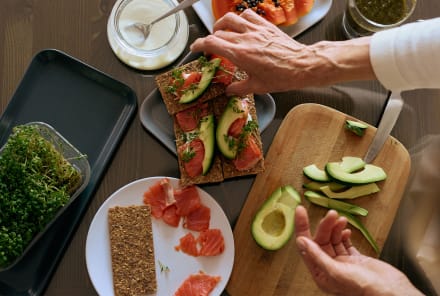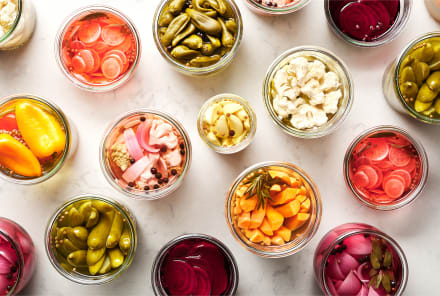Advertisement
4 Common Nutrient Deficiencies In Women Under 50 (And What To Do)


Most adults aren’t meeting all of our micronutrient (think vitamin and mineral) recommendations1. And women under 50—more specifically those who haven’t reached menopause—are particularly prone to falling short on key nutrients vital to their reproductive years and longevity. This is true even for those eating a well-balanced diet.
So we rounded up the four most common nutrient inadequacies women face during their 20s, 30s, and 40s, and how you can address them.
Iron
Iron deficiency among women is alarmingly common. Researchers of a 2021 study estimated that about 17% of menstruating women2 are deficient in the mineral. And a 2023 study published in JAMA found that up to 40% of girls between the ages of 12-213 had low levels of this essential mineral.
This should be alarming because iron plays a vital role in making DNA, supporting energy production, and carrying oxygen throughout the body in red blood cells. So not having solid enough stores can leave you feeling fatigued and lightheaded.
Why do women fall short? Since iron is found in every single red blood cell, any time there is blood loss (like menstruation) or an increase in blood volume (like during pregnancy), you need more iron to maintain proper balance and stores of the mineral. That’s why women under 50 require at least 18 milligrams of iron daily4 and pregnant women require 27 milligrams whereas postmenopausal women (and men) only require 8 milligrams.
Vitamin D
Vitamin D is one of the most common nutrient deficiencies in the U.S. (and the world). About 29% of adults in the U.S. are deficient & 41% are insufficient5 in this vitamin. This is especially concerning for women because vitamin D plays an important role in thyroid health, pregnancy, and bone health.
And while you think you may have decades before you need to start worrying about conditions like osteoporosis (that disproportionately affects women), bone density actually peaks between the ages of 25 and 35. So having sufficient levels of vitamin D during this time is vital for optimizing calcium absorption and bone mineralization (increasing bone density and overly bone mass).
Why do women fall short? While some foods (like salmon, trout, and eggs) contain vitamin D, it’s a pretty abysmal amount for helping you reach and maintain sufficient vitamin D levels (most people need about 5,000 IU per day of vitamin D to do that). And while you can get some vitamin D from the sun, living in cold, cloudy climates and even safe sun exposure practices like wearing sunscreen, limit the vitamin D you’re able to get.
Folate
Folate is a crucial B vitamin that supports DNA synthesis and cell division. So it is especially important during the early stages of pregnancy to prevent neural tube defects6. It also plays a key role in breaking down the amino acid homocysteine, which can be harmful if levels are elevated.
Why do women fall short? Even with eating folate-rich foods like dark leafy greens, beans, nuts, and seeds, women may not be getting sufficient amounts of folate.
Several studies show that oral contraceptives (birth control pills) may deplete folate status7—with women taking birth control often having lower blood folate levels than those not on oral contraceptives.
And it’s estimated that more than 50% of the population8 have a genetic variation (the MTHFR gene) that makes it challenging to convert folate from food to the active form of the vitamin the body can use. Even the supplemental folic acid form of folate is impacted by this.
Vitamin B12
Vitamin B12 plays a role in energy energy production and supports red blood cell production (along with iron). So not getting enough B12 can also leave you feeling lethargic and fatigued.
Why do women fall short? Vitamin B12 is another nutrient7 that birth control pills can deplete. And as women are twice as likely as men9 to follow a vegan or vegetarian diet (and have stronger preferences for plant-based products), getting enough of this vitamin through natural food sources like meat, seafood, eggs, and dairy may be a challenge.
What to do about it?
First and foremost, it’s important to make sure you’re consistently eating a balanced diet. That means getting enough protein (most women need at least 100 grams a day), colorful fruits and vegetables, and whole grains each day.
But again, this isn’t always enough to correct the inadequacies of these nutrients or to maintain optimal levels of them. And that’s where smart supplementation comes in. A thoughtfully formulated multivitamin (or prenatal for those who are pregnant), can help fill these nutrient gaps.
Here's what you should look for:
- Activated forms of all eight B vitamins: For folate, that’s methylfolate, and for B12 that’s methylcobalamin
- At least 1,000 IU of vitamin D3: You may want to even consider a adding an additional vitamin D supplement to really boost your levels
- One that contains iron: Many multivitamins don’t contain iron. A good place to start is with one that contains at least 9 milligrams of iron (and if you’re pregnant, opt for one with at least 27 milligrams). Some forms of iron are harsh on the stomach, so look for a multi with a gentle form of iron like ferrous bisglycinate chelate on the label
- A full array of vitamins and minerals: While you want to make sure you’re getting enough of these four nutrients, don’t neglect others like magnesium, vitamins A, E, and C, as well as calcium, iodine, and zinc. Some women’s multis only contain eight or so ingredients—not making them a very nutritionally complete option to lean to
The takeaway
In addition to eating healthfully, many women would benefit from taking a high-quality multivitamin. We did the research (so you don’t have to) and rounded up the top multivitamins for women here.
9 Sources
- https://www.ncbi.nlm.nih.gov/pmc/articles/PMC7352522/
- https://pubmed.ncbi.nlm.nih.gov/34329578/
- https://jamanetwork.com/journals/jama/fullarticle/2806540
- https://ods.od.nih.gov/factsheets/Iron-HealthProfessional/
- https://www.cambridge.org/core/journals/british-journal-of-nutrition/article/vitamin-d-deficiency-and-insufficiency-among-us-adults-prevalence-predictors-and-clinical-implications/44E436843510FE6BDE856D5BCB9C651F
- https://ods.od.nih.gov/factsheets/Folate-HealthProfessional/
- https://www.ncbi.nlm.nih.gov/pmc/articles/PMC4922824/
- https://pubmed.ncbi.nlm.nih.gov/19356019/
- https://www.mdpi.com/2071-1050/12/16/6292#:~:text=men%20and%20women.-,Across%20Western%20societies%2C%20women%20are%20twice%20as%20likely%20as%20men,follow%20a%20vegan%2Fvegetarian%20diet.
Watch Next
Enjoy some of our favorite clips from classes
Enjoy some of our favorite clips from classes
What Is Meditation?
Mindfulness/Spirituality | Light Watkins
Box Breathing
Mindfulness/Spirituality | Gwen Dittmar
What Breathwork Can Address
Mindfulness/Spirituality | Gwen Dittmar
The 8 Limbs of Yoga - What is Asana?
Yoga | Caley Alyssa
Two Standing Postures to Open Up Tight Hips
Yoga | Caley Alyssa
How Plants Can Optimize Athletic Performance
Nutrition | Rich Roll
What to Eat Before a Workout
Nutrition | Rich Roll
How Ayurveda Helps Us Navigate Modern Life
Nutrition | Sahara Rose
Messages About Love & Relationships
Love & Relationships | Esther Perel
Love Languages
Love & Relationships | Esther Perel

















